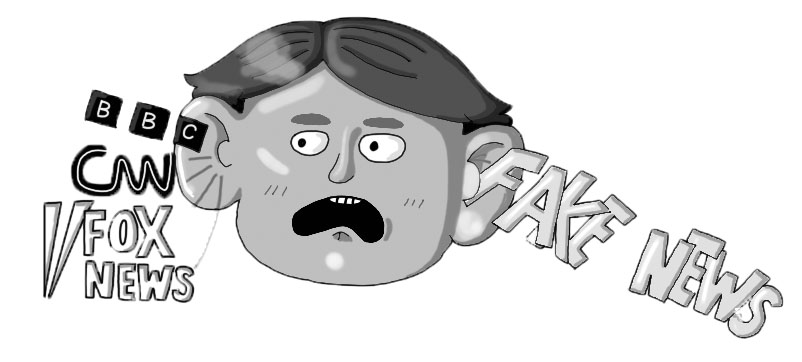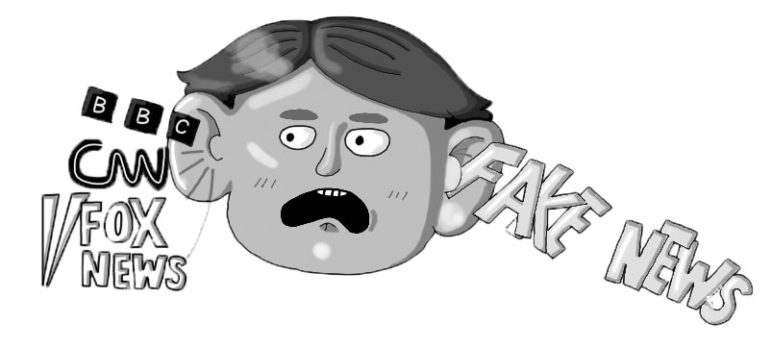

It’s the first thing millions of people hear in the morning. It’s the voice that comes from the radio as students drive to school. It’s what keeps people from staggering blindly through life, trapped in a bubble of their own making.
It’s the news. And it’s being attacked by a single word resonating from countless voices: “fake.”
The term “fake news” has become omnipresent in today’s vernacular since Donald Trump’s election in 2016. The term has evolved to encompass not only fabricated stories, but also sensationalized headlines and slanted articles that people label as “fake” instead of as alternative points of view. However, with a generation of teenagers being raised with the news delivered as fact in one ear and undercut as “fake” in the other, the question of what to believe is growing more and more complicated.
Journalist Julia Sulek from The Mercury News speaks about the dangers of the term “fake news” itself.
“The crisis for journalism and the First Amendment is … attacking journalists with integrity as purveyors of fake news,” Sulek said. “What’s dangerous about it is that it undermines people’s willingness to believe the truth, and if people don’t believe information reported by journalists who are doing their best to get to the truth and only believe some twisted version of it, that is dangerous for the country and … democracy.”
When the term “fake news” permeates top headlines, it’s easy for the public to point fingers at the media. Last year, Facebook was slammed for allowing Cambridge Analytica to access their users’ personal information to formulate content to manipulate the election of 2016 and again for Russian accounts spreading fake news. In an effort to redeem themselves, Facebook implemented a new system to crack down on misleading content, resulting in a 75 percent reduction of fake news shared on Facebook, according to the MIT School of Management.
But are teenagers more susceptible to fake news in a world with so many platforms? Junior Ryan Tavola believes so.
“With mediums such as Instagram or Snapchat, where there aren’t super reputable journalists curating anything … people just assume … it must be true,” Tavola said. “That’s not to say that all teenagers are stupid and have no capability whatsoever, but many are more inclined to go for the hyperbolic sources over more reasonable sources.”
According to the BBC, when asked where they got news from, in their top five, 12 to 15-year-olds listed YouTube and Instagram, platforms where sensationalized titles dominate. Freshman Sofia Callol finds it difficult to navigate a digital world where legitimate news is easily drowned out on such platforms.
“On Snapchat, if you look at the recommended subscriptions … there’s a lot of weird stuff that just doesn’t sound true,” Callol said. “[There’s] a lot of clickbait.”
Skepticism extends beyond attitudes towards newspapers and online sources and into people’s day to day mindsets.
“When somebody hears a story that he or she may not like, whether it’s true or not, it is often categorized as fake news,” said San Francisco Chronicle reporter Steve Rubenstein. “It’s too bad that people are … casting aside their common sense … and they’re letting their slant get in the way of adding up two and two and coming up with four.”
The problem of “fake news,” both fabricated stories and the term itself, reaches beyond the realm of media and politics. Whether one is a direct or indirect consumer of news, the fake news phenomenon catches up to all.
“People are so confused about what the truth is because of the term of ‘fake news’ all the time that they’re tuning out and saying, ‘Well, I don’t know what to believe anymore, so I’m not going to believe anything. I’m going to tune out, and I’m not going to vote, I’m not going to care, or I’m not going to speak out,’” Sulek said. “And that’s the worst thing for democracy.”
However, this startling possibility doesn’t have to come to fruition: Studies show that adults 65 and over shared almost seven times as many articles from fake news sources as those ages 18-29, according to a study conducted by researchers at Princeton and NYU. The youth seems to be making their own more sound judgements, and many like Rubenstein see a bright future.
“I have no doubt that the teenagers in the world … will figure this out,” Rubenstein said, “I have confidence that you’ll be smart — smarter than we are.”




